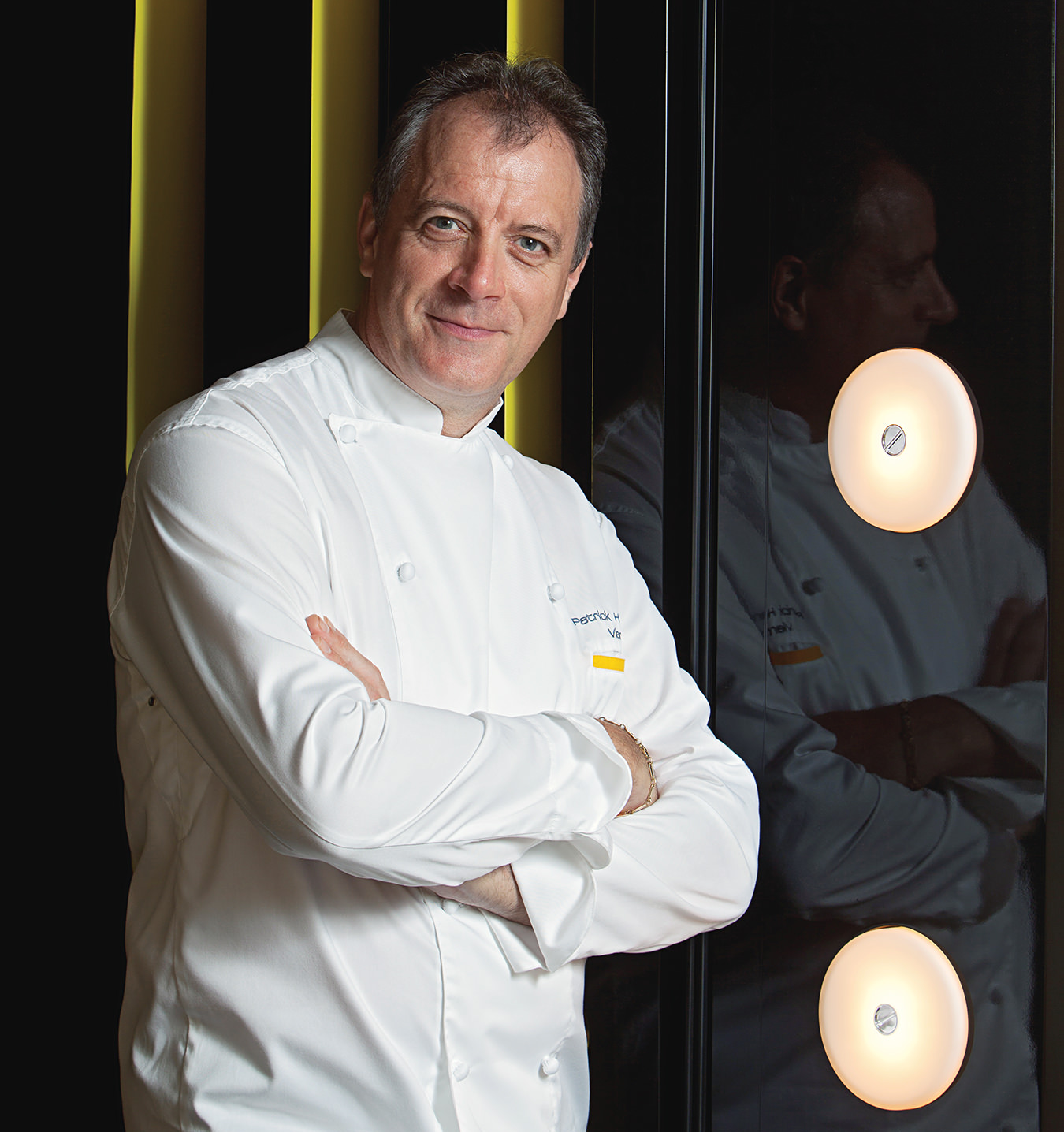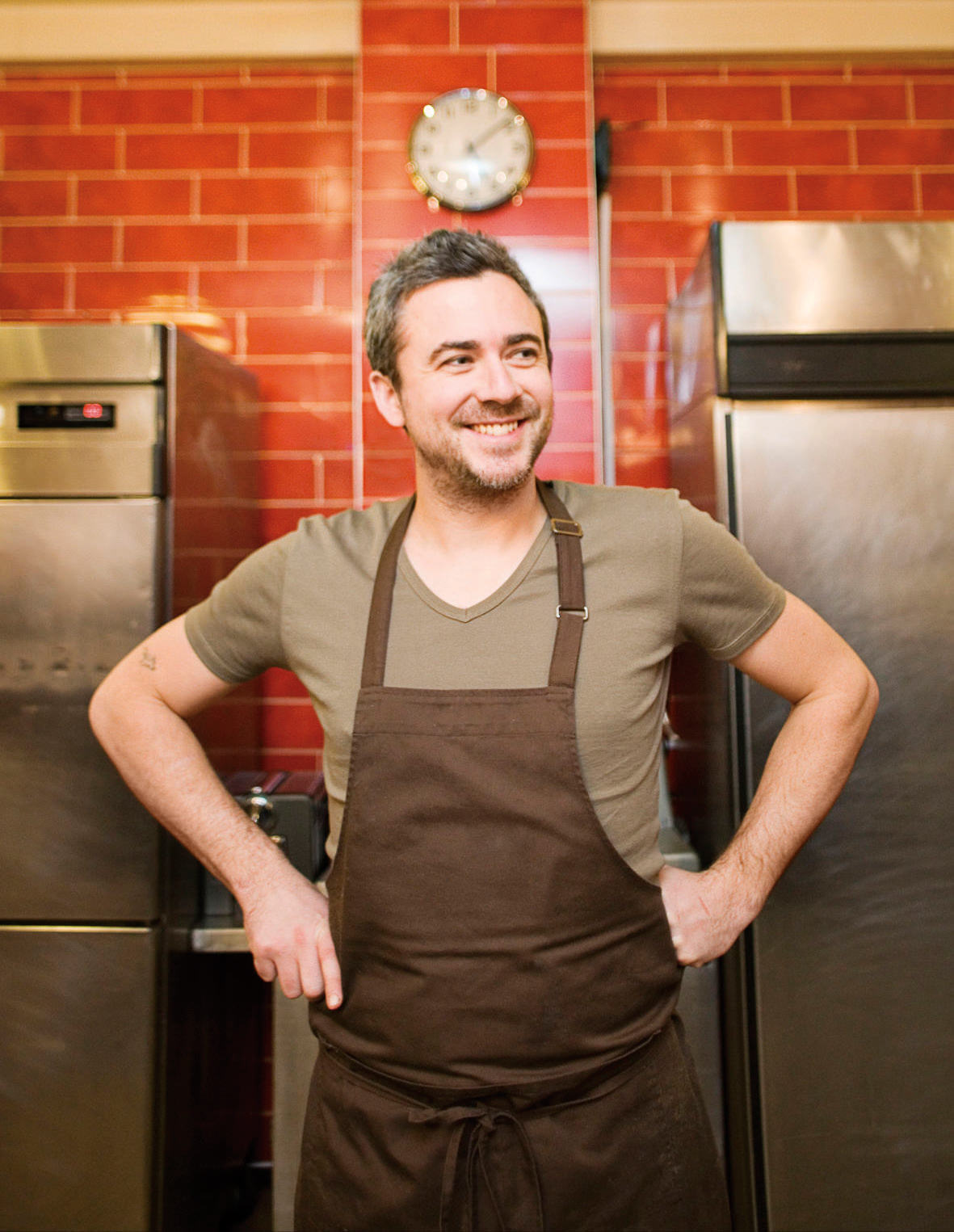-

Chef Patrick Henriroux.
-

Chef Patrick Henriroux’s cuisine is contemporary, yet his ultimate goal is to emphasize the magnificent bounty of the Rhone valley.
-

-

La Pyramide, located in Vienne, France, is a small country house set in a quiet garden behind a high wall, as it has been for over 100 years.
Chef Patrick Henriroux
Temple of gastronomy.

Located in the southwest of France some 30 kilometres south of Lyon, Vienne is a city famous for its cuisine. Yet when driving through its narrow streets, all the bistros, cafés, patisseries, and boucheries whiz past in a blur. For the diehard foodie there is but one destination in Vienne: La Pyramide. Situated steps from the city’s Gallo-Roman, white stone La Pyramid (the inspiration for the establishment’s name), this was the restaurant was once run by none other than the legendary Fernand Point, the chef widely regarded as the father of French nouvelle cuisine.
If Point’s name doesn’t ring a bell, you may have heard of Paul Bocuse, France’s most renowned chef, who apprenticed under Point back in the fifties. Other disciples include Alain Chapel, Louis Outhier, the Troisgros brothers, and the Haeberlin brothers, who went on to become the elite of French cuisine for the three decades to follow. Portly, erudite, and known for quaffing a magnum of champagne daily, Point drew quite the cast of faithful customers over the 30 years he cooked and held court at his restaurant. Jean Cocteau, Igor Stravinsky, Clark Gable, Rita Hayworth, and the Aga Khan III, as well as the Duke and Duchess of Windsor, were regulars, along with many a Parisian socialite who stopped at La Pyramide en route to the Côte d’Azur on the well-travelled “route des vacances,” the Route Nationale 7.
One of France’s first chef-owners, Point was known as an eccentric character: jovial, hard-working, immensely creative, and charismatic. Yet, first and foremost, he was one of the country’s top chefs, earning the ultimate three-Michelin-star rating from 1933 until his death in 1955. Deceased at the age of 58, Point lived on in reputation through his wife, Marie Louise (Mado), who maintained the restaurant’s high standards and scripted all the menus by hand until she passed away in 1986.

With no heir to take over the kitchen, La Pyramide was sold by the Points’ adopted daughter in 1988 to a Parisian real estate company. The property then spent a year under renovation, taking on a 24-bedroom hotel, a new restaurant space, a garden, and a covered terrace. (Only the wine cellar remains in its original location.) Several top chefs were approached to take over Point’s legendary restaurant. All refused, save for a talented 30-year-old who was making a name for himself at La Ferme de Mougins near Cannes. Enter Patrick Henriroux.
The challenge of modernizing this, the most classic of French restaurants and a true-blue haute temple de la gastronomie, was monumental. The Point legacy looms large. But Henriroux was up to the task. “La Pyramide was no longer featured in any national or international guidebooks,” says Henriroux. “We opened on June 18, 1989, and seven months later we earned our first Michelin star. In 1992 we earned our second. It was quite an adventure.”
Six years after launching the revamped restaurant, the Parisian investors experienced financial difficulties. Unwilling to see their famous restaurant go under, Vienne locals threw their support behind the young chef, and, by 1996, a settlement was reached that offered Patrick Henriroux and his wife, Pascale, a chance to purchase the property. In 1998, La Pyramide was theirs.
For more than two decades, La Pyramide has maintained its respectable two-star rating, and it has been a member of the prestigious Relais & Châteaux since 1999. Earlier this year, on a visit, I asked a member of the wait staff if they were aiming for that elusive third Michelin star. “Of course we all want it,” said the young serveur, “but I think Mr. Henriroux is happy the way we are.”
When you meet the chef, you understand the waiter’s words. Standing at the pass in the kitchen during the dinner service, Patrick Henriroux, 55, is all smiles and, despite the establishment’s 49 employees buzzing around him, is about as relaxed a chef as you’ll ever meet. Watching him in the kitchen transforming frogs’ legs (cuisses de grenouille, a local delicacy) into tiny drumsticks, you can see this is a man equally happy with his hands deep in frog flesh as he is greeting customers in the dining room.
Henriroux’s style is contemporary, but his route to “chefdom” was traditionally French. Like so many chefs, he credits his grandmother for giving him the taste for la bonne cuisine. The son of dairy farmers, he began working in kitchens at the age of 14, helping out his uncle who was a cooking teacher. After hotel school he worked under several of France’s leading chefs, most significantly Georges Blanc, before taking over—make that resuscitating—La Pyramide.
There’s no missing the sense of intrigue that arises when dining at a restaurant with this much history. The Point presence is so strong, you get the feeling that you’ll run into this towering figure every time you turn a corner. And yet the last word one would use to describe Henriroux’s approach is nostalgic. La Pyramide today is one chic contemporary restaurant. For chef Henriroux, constant renewal has been the key to survival. In 2005, the restaurant was given a full facelift (and is due for another in 2015), and in 2009 the chef and his wife opened a more casual bistro on the premises, L’espace PH3.
“A restaurant such as Paul Bocuse’s L’Auberge du Pont de Collonges near Lyon is like the Louvre of cooking,” says Henriroux. “Dining there is like choosing to listen to Mozart over Jay-Z. Because Monsieur Paul is not well these days, the restaurant’s rooms are full of people eager for this last chance to taste the master’s cuisine. And that’s a good thing for them. But for us, we couldn’t keep this restaurant going like a museum, some sort of mecca of French haute cuisine. There would be no creativity. Restaurant cooking is not something that is static. It must evolve all the time. And Point himself was so modern and such a forward thinker that his restaurant must be modern.”
An evening at Henriroux’s table in the restaurant’s dramatic black and yellow dining room offers this great contrast between past and present, formal and relaxed, edgy and classic. Point was famous for dishes including foie gras en brioche, poularde en vessie (a Bresse chicken poached in a pig’s bladder), gratin dauphinois (potato slices simmered with milk and cream, then browned with cheese), and the famous chocolate ganache, praliné, and hazelnut layer cake known as Marjolaine. Many restaurants still honour Point’s recipes—his filets de sole, for example, feature prominently on the menu at L’Auberge du Pont de Collonges. By today’s gastronomic standards, however, these dishes are hardly ground breakers. Yet in Point’s era, revolutionary cooking was epitomized by dishes like his famous salade délice, featuring barely cooked haricots verts, julienned mushrooms, truffle slices, diced duck liver, and tomato supremes. Copied the world over, this simple délice became one of the iconic dishes of nouvelle cuisine.

Henriroux’s cooking is modern, yes, but it steers clear of the passé trend of all things molecular. His cuisine is complex, yet his ultimate goal is to emphasize the magnificent bounty of the Rhone valley. Scan La Pyramide’s menu today and you’ll see dishes like pressed terrine of foie gras with artichokes, hibiscus pâte de fruits, and caramelized onion kougloff, or escargot tart with asparagus ragout and burgundy-style jus. For dessert, the incomparable Mara des Bois strawberries are paired with long pepper, light vanilla mousse, and pink champagne jelly. The food is intricate, the plating is elaborate, the flavours are true. La Pyramide remains a restaurant where service is not merely skilled but balletic and the wine list counts magnums of Château Grillet, a white viognier produced in the northern Rhone valley just south of the restaurant. Wildly sought after today, the wine was sold by the pitcher in Point’s time. La Pyramide’s cellar has proved a long-standing treasure and still impresses with a rare collection of Chartreuse, as well as old vintages of Château Lafite, Château Mouton Rothschild, and Domaine de la Romanée-Conti. The surrounding vineyards of Côte-Rotie, Cornas, Hermitage, Condrieu, and St-Joseph are as prominently featured on this list as they were in Point’s time, yet today you’ll find bottles of New World wines listed by their side.
As in all great French restaurants, a meal at Henriroux’s table comes to a close with a mind-boggling cheese selection; the local Saint-Marcellin cheese is a favourite from the Point era and remains an absolute must. And for those eager to end with a sweet, classic note, the spectacular Grand Marnier soufflé is the ne plus ultra. An old French warhorse of a dessert, the soufflé, towering above its ramekin, is pierced and filled with a pitcher’s worth of luscious Grand Marnier crème anglaise. With an equally airy glass of demi-sec champagne, it’s the ideal way to finish a meal at this legendary restaurant.
Photos ©Jean-Marc Palisse.




